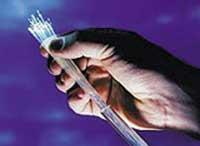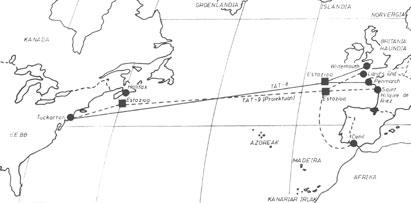Fiber optic: At the base of information highways
2000/01/09 Kortabarria Olabarria, Beñardo - Elhuyar Zientzia
Thanks to fiber optics, the ability to send data has increased considerably in recent years. After World War II, to make a call from Europe to Asia, short radio waves were sent to the ionosphere to bounce back to Earth. In this way, the connection needed hours to get a call for a few minutes and interference often occurred. As the technique progressed, steps were also taken in the field of communications. Thus, in 1956 the first transatlantic copper cable was launched, which simultaneously allowed 36 telephone calls to be made. In 1960, 5 million phone calls were made between continents. It was then that communications satellites arrived, in the mid-1960s, an important step. By 1980, 200 million transatlantic calls were made annually.
However, technology could not respond to the demand in the field. The technology itself was at the limit and the need for a better system was evident for data transport. You started thinking about solutions and it occurred to you that the most efficient transportation to send information to someone could be clear. It was the beginning of the era of optical fiber.

Optical fibers are mirror-filled cables to carry light with the lowest possible loss. This light transmission is based on a theory of optics: total internal reflection. According to this theory, if it is a border attack angle, above this limit there are no refracted rays for higher attack angles, so all the energy is reflected. Fiber optic cables do not lose light while moving inside the tube. Although fiber optic applications are relatively new, basic features have long been known. By 1820 Augustine-Jean Fresnel defined the equations of light capture on glass plates. In 1910 Demetrio Hondrose and Peter Deby developed these theoretical equations for glass wall cables. In 1964, Stewart Miller determined how these glass cables could be used to send data. This caused that, especially in industry and medicine, fine glass threads were used to bring light anywhere, but not very efficient. For example, 99% of the light was lost on the 9 meter fiber cable. In 1966, Charles Kao and George Hockham found that the loss was not due to the limited ability to send data by glass, but to the impurities generated in the glass manufacturing process, especially water and metals. After both researchers reported their conclusion, many scientists began researching glass fibers until in 1970 one was discovered that barely lost. Shortly thereafter a laser semiconductor was discovered that could be used at room temperature and at the same time new optical fiber manufacturing techniques were developed. With these changes came the revolution in the field of fibers, which came out of the laboratory and began to be used in engineering.
In the decade following these discoveries much progress was made in the field of optical fiber, as they obtained fibers that increasingly lost less information. If in 1980 the information signal in the best fibers lost intensity, it had to travel at least 240 kilometers. However, the fibers of this level could not be obtained by conventional techniques, since to avoid the entry of dirt had to take very special and rigorous measures. The change came with pure silicon compounds. These compounds do not collect impurities, but to achieve them it was essential the development of chemical thermodynamics, something that did not occur until the 1980s.
Today's fiber optic cables can be thinner than human hair and in turn more resistant than steel. With the help of laser development, fiber optics has helped dramatically increase the capacity of telephone and internet communications. Applications are not limited to this, as they are increasingly used in astronomy, medicine or industry. Without fiber optics, existing communication highways could never be built.
Advantages of fiber optics
- Optical fiber is not a conductor of electricity, so there is no risk of electrocution.
- Optical fiber is not a conductor of ultraviolet radiation. Many materials, such as artworks found in museums, lose quality by undergoing ultraviolet radiation.
- Optical fiber is not an infrared radiation conductor. This means that optical fibre-based systems do not carry heat, which can be very good for very heat sensitive circuits.
- Optical fiber is very good for light targeting, allowing its use in systems that require light targeting. The use of optical fibers can also reduce the number of conventional spotlights used in lighting.
- The light source that transports the fiber is outside the fiber optic system, so when changing the light source it is not necessary to make changes in the fiber optic.
Published in 7

Gai honi buruzko eduki gehiago
Elhuyarrek garatutako teknologia





